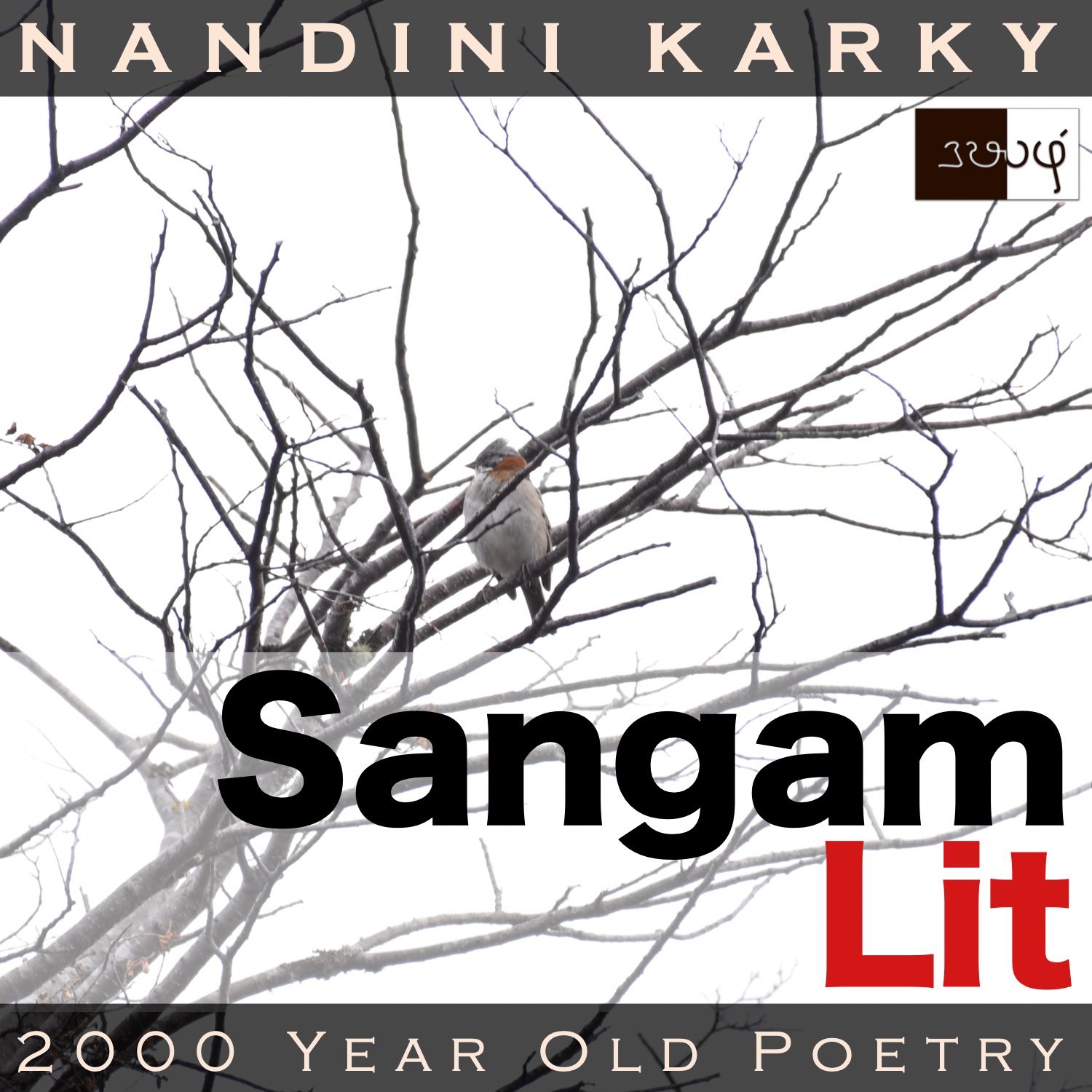Podcast: Play in new window | Download
Subscribe: Apple Podcasts | Spotify | Amazon Music | Android | iHeartRadio | TuneIn | RSS | More

In this episode, we perceive the joy in a man’s homecoming, as depicted in Sangam Literary work, Natrinai 394, penned by Avvaiyaar. The verse is situated in the forests of ‘Mullai’ and speaks in the voice of wayfarers, seeing the man returning homeward from a mission.
மரந்தலை மணந்த நனந் தலைக் கானத்து,
அலந்தலை ஞெமையத்து இருந்த குடிஞை,
பொன் செய் கொல்லனின், இனிய தெளிர்ப்ப,
பெய்ம் மணி ஆர்க்கும் இழை கிளர் நெடுந் தேர்,
வன் பரல் முரம்பின், நேமி அதிர,
சென்றிசின் வாழியோ, பனிக் கடு நாளே;
இடைச் சுரத்து எழிலி உறைத்தென, மார்பின்
குறும் பொறிக் கொண்ட சாந்தமொடு
நறுந் தண்ணியன்கொல்; நோகோ யானே?
Opening with the words ‘மரந்தலை மணந்த நனந் தலைக் கானத்து’ meaning ‘a wide forest, brimming with trees’, the verse paints for us, a jungle landscape. Wouldn’t it be a real treat to traverse this ancient forest? Can’t help wondering how it smelt and sounded! Speaking of sounds, we glance at ‘ஞெமையத்து இருந்த குடிஞை’ meaning ‘an owl that lived on the ‘gnemai’ tree’ and its ‘sweet sound’ in ‘இனிய தெளிர்ப்பு’. As seen in Natrinai 369, the ‘gnemai’ is an unidentified Sangam tree, which was mentioned as growing on the high peaks of the Himalayas. Possibly, a deciduous tree that had come south! Another sound is heard in ‘பெய்ம் மணி ஆர்க்கும்’ meaning ‘with bells resounding’, talking about the quintessential part of a ‘tall chariot’ or ‘நெடுந் தேர்’. Next in line to speak is the ‘இடைச் சுரத்து எழிலி’ referring to ‘the rainclouds in the drylands path’. The phrase ‘குறும் பொறிக் கொண்ட சாந்தமொடு’ meaning ‘ little specks of sandalwood’ clicks an image of an ancient person daubing themselves with sandalwood paste. The verse ends with ‘நோகோ யானே’ meaning ‘would I worry’ and invites us to listen intently.
The man and lady had been leading a happy, married life when the man had to leave on a mission. He promises her that he would return before the rains and the lady begins her patient wait. One day, wayfarers see the man returning and say, “In the wide open spaces of the forest, filled densely with trees, perched on a dried-up ‘gnemai’ tree, an owl lets out a pleasant call, akin to the sound from a goldsmith’s anvil. Just then, with its bells resounding, this tall and decorated chariot plied on a pebble-filled path, with its wheels thundering, on that harsh, cold day! Hearing the sound of the raincloud in the drylands, here he comes, the cool and fragrant one, with little spots of sandalwood on his chest. Would I be worried now?” With these words, the wayfarers echo the joy that the lady would feel in the man’s return by the promised time.
Time to explore the tiny details! The first image presented is that of a thick forest, tightly packed with trees. From the forest, the focus zooms on to a single tree and this is a ‘gnemai’ tree, bereft of leaves and fruits. This adds further strength to our surmise that it could be a deciduous tree, which loses its leaves, unlike its evergreen companions in the forest. Moving closer to the ‘gnemai tree’, we catch a glimpse of an owl perched on it. Perhaps, it has its nest in the tree’s trunk! Anyway, more than the sight of this owl, it’s the sound it makes that enchants us, and the wayfarer, who is revealing this scene, informs us how close it sounds to the clang of a gold worker’s smithy. Owl sounds have been recorded but where do we go for the sound of an ancient smithy? The owl sound is not just mentioned here but qualified as a pleasant sound as well! Makes me curious to visit some traditional goldsmith and listen closely to the sounds in their workshop. Returning to the verse, this entire description has been outlined to say that the man’s chariot passed this owl and this tree, bells clanging, on a harsh winter’s day. Now, we understand that the wayfarer has been talking about the past, when the man left the lady to go on his mission of gathering wealth. Perhaps, they met him when he was on his way towards the drylands path, and shared a word or two!
The wayfarer now brings us to their present moment when the man is seen heading towards his home. No doubt he heard the sound of rainclouds gathering in the sky and immediately remembered his promise to the lady to be back before the rains. So, his chest smeared with the cool and fragrant paste of sandalwood, with only little dots left after that long journey, he now rushes home to be with his beloved. With a question wondering if there is any cause for worry, the wayfarer ends his account. Why talk about worry in these happy circumstances, I wondered, and then recollected how the ancients refer to ‘black’ as ‘not white’, and concluded that this was an expression of joy, by talking about the absence of sorrow. Not only is the wayfarer talking about his joy, but also that of the man, and more importantly, the lady, who would heave a sigh of relief at the man’s homecoming in the promised time. A few lines of verse and we know of the seasons that changed and the reasons that propelled the man back home. Most importantly, as this wayfarer succinctly demonstrates, happiness is delightful, not only when it comes knocking at one’s own door, but even when it happens to another, illustrating the web of oneness that binds us all!




Share your thoughts...